In the year 767 Stephen of Constantinople saw soldiers trampling an  icon. He objected and was told it was ok – it was only a picture. So he took a coin with the image of the Emperor and trampled it, explaining it was only a picture. We celebrate the feast of Saint Stephen the New Martyr every November 26. The Emperor didn’t forbid images of himself, only of Christ and the saints. You get the picture?
icon. He objected and was told it was ok – it was only a picture. So he took a coin with the image of the Emperor and trampled it, explaining it was only a picture. We celebrate the feast of Saint Stephen the New Martyr every November 26. The Emperor didn’t forbid images of himself, only of Christ and the saints. You get the picture?
In these two weeks we’re digging deeper into the history and theology of iconography. Last week we looked at the origins of icons. Now we move ahead to the attempt to eliminate Orthodox iconography and its permanent restoration.
The Iconoclastic Controversy
No Ecumenical Council had dealt specifically with the theology of images – until the challenge of the Iconoclastic movement in the 8th century.
Iconoclast means “icon smasher”. In the year 726 Emperor Leo III the Isaurian began a systematic attack on the holy icons. Icons were removed from public ![]() places, taken out of churches and homes, mutilated, burned, destroyed in various ways – except for a few which people managed to hide away, or were preserved outside the Empire. Some in the Church went along with the Emperor, especially clergy who knew which side their bread was buttered on.
places, taken out of churches and homes, mutilated, burned, destroyed in various ways – except for a few which people managed to hide away, or were preserved outside the Empire. Some in the Church went along with the Emperor, especially clergy who knew which side their bread was buttered on.
What caused the Iconoclastic movement? It’s not clear. Just as today, political or religious movements suddenly sweep the country or the world, many of them making radical changes. But why? Often it’s hard to say.
Iconoclasts quoted the Second Commandment (see last week), but the Iconoclastic emperors, like most politicians, knew little about religion. Likely the chief influence was political, not theological. The Empire was then threatened by iconoclast Muslims who were winning battle after battle. The Muslim Caliph Yezid had just ordered the removal of all icons and images within his dominions, so Emperor Leo came to the “obvious” conclusion…
Iconoclasm was not a popular movement. As I said last week, imagine if the government wanted to destroy that icon which had long been passed down through your family * or the icon in church that has spoken so deeply to you.
- as, believe it or not, the American military were doing in the Aleutian Islands as late as World War II. Was it Ronald Reagan who finally apologized for that?
Those who understood Orthodox theology resisted. They saw that this was not just an argument about pictures but about the very nature of Christianity. Was “the Word made flesh”? Did he take on an image? Have we “beheld his glory”? Can he be pictured? Whether unintentionally or intentionally, the Iconoclasts were ultimately denying the Incarnation, the humanity of Christ. Monks and theologians who opposed Iconoclasm were jailed, exiled and some martyred.
In the end Iconoclasm became a war between Church and state. In the Byzantine synthesis bishops were to tend to the Faith, emperors to secular affairs. Emperor Justinian had defended Orthodoxy, even against his Empress! and that was fine – but Iconoclastic emperors were reaching beyond their proper sphere of influence.
Defenders of the Holy Icons
 Iconoclasm caused the Church’s theology of icons finally to be clearly thought through and spelled out. Saint Theodore of Studion Monastery in Constantinople got himself into much trouble because writings things like this: “Because man is in the image and likeness of God, there is something divine about the act of painting an icon.” He also drew out the moral implications – about a thousand years before emancipation caught on in the world: “You shalt possess no slave, neither for domestic service nor for the labor of the fields, for man is made in the image of God.”
Iconoclasm caused the Church’s theology of icons finally to be clearly thought through and spelled out. Saint Theodore of Studion Monastery in Constantinople got himself into much trouble because writings things like this: “Because man is in the image and likeness of God, there is something divine about the act of painting an icon.” He also drew out the moral implications – about a thousand years before emancipation caught on in the world: “You shalt possess no slave, neither for domestic service nor for the labor of the fields, for man is made in the image of God.”
The most eloquent defender of icons was John Mansour, later known as Saint John of 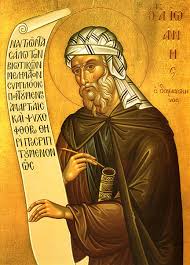 Damascus, who wrote from the safety of Muslim territory (note the turban), where the emperors couldn’t get him. A multi-talented man, John worked at first as secretary to the Caliph of Damascus who protected him! In one of his Apologetic Treatises against those Decrying the Holy Images Saint John wrote: “Of old the incorporeal and invisible God was not depicted at all, but now, since God has appeared in the flesh and dwelt among men, I make an icon of God since he has become visible. I do not venerate matter but I venerate the Creator of matter, who for my sake has become material, who has been pleased to dwell in matter and has through matter effected my salvation. I shall not cease to honor matter, for it was through matter that my salvation came to pass. Do not insult matter, for it is not without honor; nothing is without honor that God has made.”
Damascus, who wrote from the safety of Muslim territory (note the turban), where the emperors couldn’t get him. A multi-talented man, John worked at first as secretary to the Caliph of Damascus who protected him! In one of his Apologetic Treatises against those Decrying the Holy Images Saint John wrote: “Of old the incorporeal and invisible God was not depicted at all, but now, since God has appeared in the flesh and dwelt among men, I make an icon of God since he has become visible. I do not venerate matter but I venerate the Creator of matter, who for my sake has become material, who has been pleased to dwell in matter and has through matter effected my salvation. I shall not cease to honor matter, for it was through matter that my salvation came to pass. Do not insult matter, for it is not without honor; nothing is without honor that God has made.”
The Seventh Ecumenical Council
After 54 years of imperial persecution, in the year 780 the Empress Irene called a Council in Nicaea to deal with the issue – which came to be called the Seventh Ecumenical Council.
The Fathers made a distinction between veneration (προσκύνησις/prosKINisis) and worship (λαριία/ laTREIa). We worship God. We venerate saints and holy objects: icons, the Cross, the Gospel book, and all 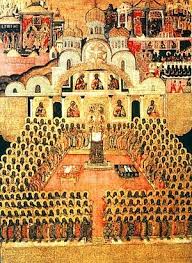 worthy people.
worthy people.
Regarding icons the Fathers established these principles:
1 Icons are not idols, because we do not worship them. The power is not in the matter but in who icons point to, in who lies behind the images. Surely this is obvious. Who has ever worshiped wood or paint? I have a picture of my parents standing in honor on my dresser, not because of the paper and ink but because of my parents. Saint Basil the Great had written long before: “The honor given to the image passes on to the prototype that lies behind it”.
Saint Leontios of Jerusalem (d. 1261) would later write: “We do not bow down to the nature of wood, but we revere and bow down to him who was crucified on the Cross…. When the two beams of the Cross are joined together I adore the figure because of Christ who was crucified on the Cross, but if the beams are separated, I throw them away and burn them.”
Furthermore icons are not false images as forbidden by the Second Commandment. Icons are true images of Christ and the saints. They protect the Faith and worship of the true God.
2 The doctrinal significance of icons is that they proclaim the Incarnation. Therefore the Fathers of the Council decreed that not only are icons permissible but that it is essential to have them – for to reject them is to deny Christ’s humanity, his materiality.
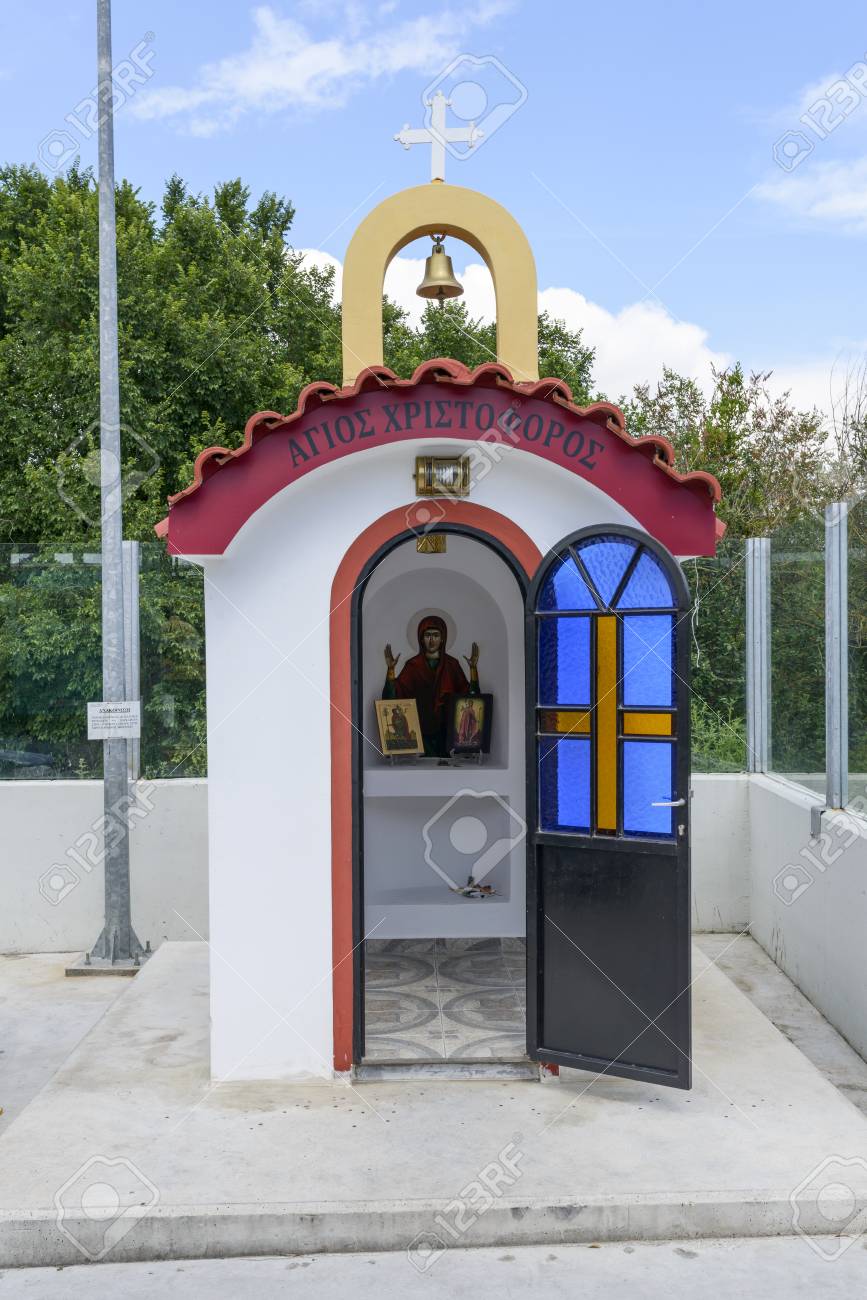 3 Therefore the Fathers continued, “As the sacred and life-giving Cross is everywhere set up as a symbol, so also should the images of Jesus Christ, the Virgin Mary, the holy angels, as well as those of the saints and other pious and holy men * be exhibited on the walls of churches, in homes and in all conspicuous places, by the roadside and everywhere” to be revered by all who see them. Left: roadside shrine in Greece
3 Therefore the Fathers continued, “As the sacred and life-giving Cross is everywhere set up as a symbol, so also should the images of Jesus Christ, the Virgin Mary, the holy angels, as well as those of the saints and other pious and holy men * be exhibited on the walls of churches, in homes and in all conspicuous places, by the roadside and everywhere” to be revered by all who see them. Left: roadside shrine in Greece
- In corners of murals in old country Greek churches (even on Mount Athos), one can occasionally find Plato and Socrates and other notable pagan philosophers!
4 The Fathers made it clear that icons are both teaching devices and also means of grace, points of contact with God and the saints. Modern theologian Nicholas Ouspensky wrote in The Meaning of Icons (page 30) that the Fathers of the Council “rejected [a proposal] to place veneration of icons [only] on a level with that of sacred vessels.” Instead “the icon is placed on a level with the Holy Scriptures and with the Cross, as one of the forms of revelation and knowledge of God… each alike is a reflection of the higher world.” Therefore in Orthodox churches the Gospel book and the icons are treated the same: we kiss them, cense them, reverence them.
Ouspensky continued: “The image like the Divine worship transmits the teachings of the Church and expresses the grace-given life of the sacred Tradition in the Church…. As the word of the Holy Scripture [conveys] an image, so the image also [conveys] a word.” As Saint Basil had written, “What the word transmits through the ear, the painting silently shows through the image, by these two means, mutually complementing one another.”
All this was implicit from the beginning in the Church. It just took the Iconoclastic controversy to cause it to be officially spelled out.
The Restoration of the Holy Icons
Did the Seventh Ecumenical Council end the Iconoclastic controversy? No. In the Orthodox Church, councils settle nothing unless they are accepted by the Church (all of us), and this is what happened, eventually. In 815 a new iconoclast Emperor, Leo the Armenian, came to the throne, and for another 28 years imperial troops were busy destroying icons again.
 Finally the Empress Theodora ended the Iconoclasm once and for all. On the First Sunday of Lent 843, beginning with a procession into Aghia Sophia in Constantinople, the holy icons were restored to the Church and all places. Each year
Finally the Empress Theodora ended the Iconoclasm once and for all. On the First Sunday of Lent 843, beginning with a procession into Aghia Sophia in Constantinople, the holy icons were restored to the Church and all places. Each year ![]() on the First Sunday of Lent, Orthodox have a procession of icons and celebrate the continuing Triumph of Orthodoxy. At the end the Synodikon of Orthodoxy issued by the Seventh Council is proclaimed:
on the First Sunday of Lent, Orthodox have a procession of icons and celebrate the continuing Triumph of Orthodoxy. At the end the Synodikon of Orthodoxy issued by the Seventh Council is proclaimed:
As the prophets beheld, as the Apostles have taught, as the Church has received, as the teachers have dogmatized, as the Universe has agreed, as falsehood has been dissolved, as Wisdom has presented, as Christ awarded, thus we declare, thus we assert, thus we preach Christ our true God, and honor His saints in words, in writings, in thoughts, in sacrifices, in churches, in holy icons; on the one hand worshipping and reverencing Christ as God and Lord; and on the other hand honoring them as true servants of the same Lord of all and according them veneration. This is the Faith of the Apostles, this is the Faith of the Fathers, this is the Faith of the Orthodox, this is the Faith which has established the Universe.
And with that began a great flourishing of iconography in the Orthodox world which has never diminished.
Later Iconoclasm outside the Orthodox Church
An extreme form of Iconoclasm arose again with the Protestant Reformation, even to the point of forbidding crosses in church – apparently in reaction to late medieval Roman Catholic superstitions. A limited form of it has appeared after Vatican II, with most images now removed from Roman Catholic churches. Only a few traditional Anglican and Roman Catholic churches have retained many images. Most Protestants now admit crosses in church. Lutherans have crucifixes. Most Protestants, though they would never allow icons or statues in church, have no problem with images in stained glass windows. Do any of you understand why?
Those of you who have “Bible church” friends or relatives know that some of them actually think we Orthodox worship images. As for those Protestants who say (incorrectly) that the Second Commandment forbids all images – one former-Southern Baptist woman, now Orthodox, said to a Baptist friend, “Honey, then throw out the teddy bears and the pictures of grandma!”
Depictions of God the Father
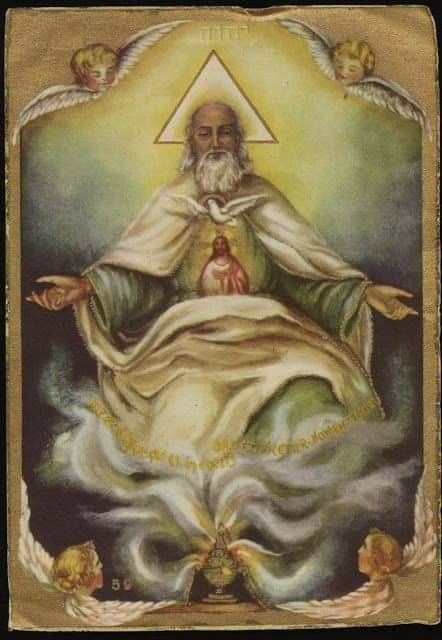 So far as I know there is only one latter-day Orthodox decree regarding icons, from the local Synod of Moscow in 1667 which forbade icons depicting God the Father as an old man,
So far as I know there is only one latter-day Orthodox decree regarding icons, from the local Synod of Moscow in 1667 which forbade icons depicting God the Father as an old man,  which he is not. In such icons, sometimes the Father was shown 1 as older than the Son, which he is not – suggesting Arianism – or 2 with the Son seated beside the Father, and the Holy Spirit (incorrectly depicted as a dove) in a lesser
which he is not. In such icons, sometimes the Father was shown 1 as older than the Son, which he is not – suggesting Arianism – or 2 with the Son seated beside the Father, and the Holy Spirit (incorrectly depicted as a dove) in a lesser ![]() position than both – suggesting the Roman Catholic doctrine that the Spirit proceeds “from the Father and the Son”. The decree of the Council did not stop this misuse, which can still be found to this day, especially in late 19th century icons. What is permissible is the symbolic depiction of the Holy Trinity in the form of the three angels (“men?”, “the Lord?”) who visited Abraham and Sarah. Right: the Rublev icon
position than both – suggesting the Roman Catholic doctrine that the Spirit proceeds “from the Father and the Son”. The decree of the Council did not stop this misuse, which can still be found to this day, especially in late 19th century icons. What is permissible is the symbolic depiction of the Holy Trinity in the form of the three angels (“men?”, “the Lord?”) who visited Abraham and Sarah. Right: the Rublev icon
Icons versus Statues versus Nothing at All
The Seventh Ecumenical Council ruled that images are required, not specifying whether Orthodox icons or Western statues. I know of no official explanation of why Orthodox never have statues. It just is. I think it may derive from our understanding of icons as “windows into heaven”. In devotions, it’s easy to focus  on three-dimensional statues as an end in themselves. Two-dimensional icons are windows into which we can more easily enter and pass through them into the Kingdom of heaven on the other side. That’s my guess.
on three-dimensional statues as an end in themselves. Two-dimensional icons are windows into which we can more easily enter and pass through them into the Kingdom of heaven on the other side. That’s my guess.
The bigger problem is the complete elimination of images or persons, for images keep our religion personal rather than solely intellectual, ideological, theological. Without images, it’s easy for Christianity to become just a matter of thinking right or believing right or saying the correct words – impersonal, dry as a bone. Before Vatican II, by chance one evening, I wandered into a Puerto Rican Roman Catholic church on the west side of Manhattan. It was filled  not only with people singing, but with a multitude of statues and candles up and down the side aisles of the church. I don’t think I had ever been in a place which seemed so alive. Now look at what has been lost. Or rather don’t look – there’s little to see. Left: modern Roman Catholic church
not only with people singing, but with a multitude of statues and candles up and down the side aisles of the church. I don’t think I had ever been in a place which seemed so alive. Now look at what has been lost. Or rather don’t look – there’s little to see. Left: modern Roman Catholic church
But walk into any Orthodox church, ancient or modern, and you see and know what the Church is all about: love, relationships with people, persons in heaven and on earth. The three Persons of the Holy Trinity, the saints and angels on high worshipping with us, and the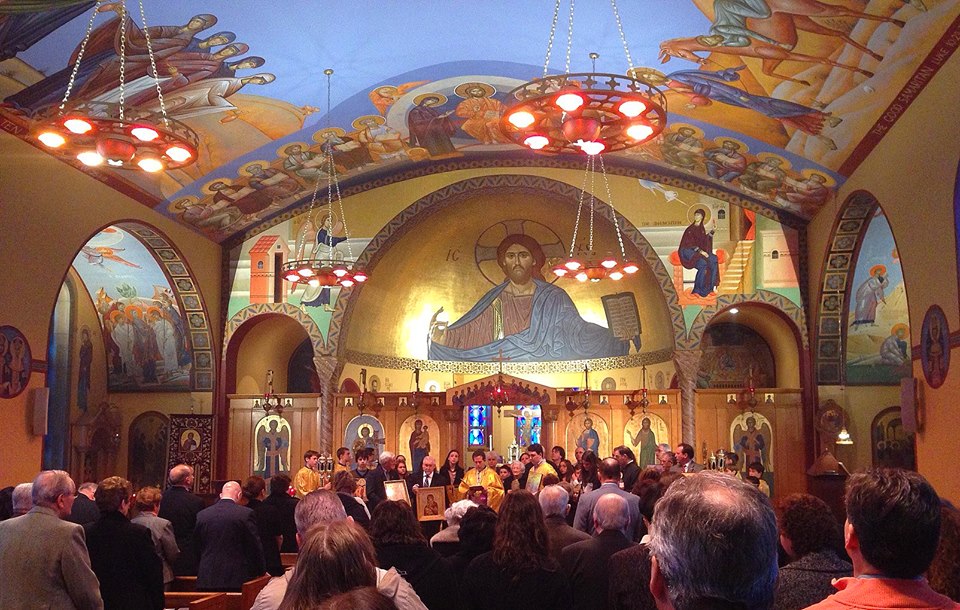 people standing beside us, all of us united in the Church. right: Saint Sophia Greek Orthodox Church, New London, Connecticut
people standing beside us, all of us united in the Church. right: Saint Sophia Greek Orthodox Church, New London, Connecticut
Our holy icons help to explain what a Methodist bishop said some years ago (This is a great oversimplification, certainly, but it points to the truth.) He said, “The Protestant church is the church of faith. The Roman Catholic Church is the church of obedience. The Orthodox Church is the church of love.”
Enough said.
Next Week: next to last of our series on the Seven Deadly Sins – Sloth
Week after Next: Saint Mary of Egypt and Penitence

Enjoying your posts, Father. Thank you.
I was kind of stunned at the mention of the U.S. military iconoclasm in the Aleutian Islands. Found some articles online. Not only is the iconoclasm a terrible thing, but the little known displacement of the Aleuts in ‘internment camps’…a long and horrifying story. Never heard it told before.
The picture of the modern RC Church…if you ignore the pews and crucifix, it looks sort of like the inside of the Star Ship Enterprise. I was raised Catholic. Back in the day, our Church sure didn’t look like that inside. Sad, isn’t it…
Probably stained glass in Anglican Churches built during the Nineteenth Century is of the Romanticism period of Art and Architecture. The church buildings have arches and windows of various mixed types and stained glass was a necessity to keep up the “Mediaeval” appearance. Romanticism was associated with National character after the period of “Classic” types of churches with pediments ,columns and domes of the Eighteenth Century an International style
Good explanation. Thank you. But I still wonder why the old “Evangelical United Brethren” (kind of “Bible church” in those days) building in which I was raised in Ohio had stained glass windows with images of Biblical scenes. I should have asked.
Regarding statuary, I think Ouspensky noted, in Theology of the Icon, that the issue was first brought up in either the first or second councils, and statuary was, while not wholly prohibited, at least downplayed. Ouspensky cited the example of the statues in front of St. Veronica’s house (still extant and described by Eusebius at the time of the first council) as being considered an exception to the rule. Ouspensky echoed the concern you cited “I think it may derive from our understanding of icons as “windows into heaven”. In devotions, it’s easy to focus on three-dimensional statues as an end in themselves,” as well as adding that an additional problem with statuary was its sensuality (something even 2-dimensional icons are not immune to). With statuary, there is always the temptation on the part of the sculptor to make the statues too real, or too perfect in form, or to model them on actual people.
I think we can see that concern borne out in many statues from the Renaissance through the 19th century, where the forms and poses are very sensual indeed, and not at all of the “windows into heaven” more fitting for a church.
Thanks for the information. Yes, I have seen icons of the Virgin Mary where her face and especially her eyes were so sensual as to be almost “suggestive”. Thank God that style was short-lived and that we have returned to classic iconography.
I’m not so sure it was short-lived. Icons “In the Italian Style” (as they are often called) began to crop up in Russia in the late 1600s (especially once Tsar Peter decided to westernize everything), and the style even took over Balkan iconography for a long time, according to Ouspensky. Classic iconography had to be “rediscovered” (meaning in this case valued by the artists and academics – the rural folk never lost it in the first place) in Russia near the end of the 19th century, after so much had been torn town, burned, buried, or covered up from Peter onwards. That’s a run of over 200 years, right up to the Revolution.
I visited a church in New England last year where the iconography, which dated from the 1940s, was also in a modern-ish style – lots of pastels and realistic (albeit not sensuous) depictions. I enquired about it, and the priest waved a hand rather dismissively at it as being “poor work of the Italian style”. It seems the reversion to classical forms has thus been pretty recent, and is something we will doubtless have to defend again and again as the years wear on, just as iconoclasm too continues to linger.
In fact there was a church here in Milwaukee that in the 1960s installed large icons in a kind of (I’m not sure how to describe it) vaguely “impressionistic” style. To the glory of God, they have been replaced now.
Couple of questions: During the 120 year period of Iconoclasm, how extensive was the removal of icons? As it was driven by the East Roman emperors, did the removal and destruction of icons extend into other, non-Roman lands? Was there a break in the “tradition” of their use (even informally) in the Orthodox Churches or did the monastics preserve the tradition?
Keep in mind that I’m no historian. I’m a “popularizer”. I just repeat what they tell me! However, my understanding is that in the Eastern Empire icons were generally removed from public places, including churches. Some people preserved their icons at home. Many monasteries opposed iconoclasm and tried to keep their icons, which got them into considerable trouble. Orthodox Christians outside the Roman Empire kept their icons and were protected by the Muslim rulers! which is why Saint John of Damascus could defend icons, unimpeded. And why Saint Catherine’s Monastery at Mount Sinai has so many very ancient icons. To the West, which was no longer part of the Roman Empire, it seems veneration of images (mostly statues) continued – though statuary in Western Christianity was just then becoming common. Will someone please correct me if I have got any of this wrong.